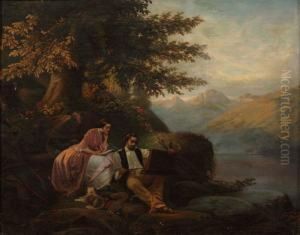Theodor Albert Sprengel Paintings
Theodor Albert Sprengel was a German painter and graphic artist, born in 1846 in Königsberg, Prussia (now Kaliningrad, Russia), and died in 1911. Sprengel's work is often characterized by its detailed and precise depiction of natural and architectural subjects, reflecting the 19th-century European art movements that emphasized realism and naturalism. He was part of a generation of artists who sought to capture the world around them with accuracy and a keen eye for detail, contributing to the evolving landscape of European art during a period of significant cultural and technological change.
Sprengel received his initial art education in his hometown before moving to further his studies in Berlin, where he was exposed to the vibrant art scene of the German capital. This period was crucial for his development as an artist, as he absorbed influences from various art movements and schools of thought prevalent at the time. He was particularly drawn to the works of the Old Masters, whose techniques he sought to understand and incorporate into his own style.
Throughout his career, Sprengel exhibited his works in numerous galleries across Europe, gaining recognition for his landscapes, still lifes, and portraits. His landscapes often depicted the German countryside and the Baltic Coast, showcasing his ability to capture the subtle interplay of light and shadow, which brought his scenes to life. Sprengel's still lifes displayed a remarkable attention to detail and texture, making ordinary objects appear extraordinary through his skillful use of color and composition.
Despite his achievements, Theodor Albert Sprengel remains a relatively obscure figure in art history, overshadowed by his more famous contemporaries. However, his contributions to the German art scene of the late 19th and early 20th centuries continue to be appreciated by art historians and collectors who recognize the quality and depth of his work. Sprengel's legacy is that of a dedicated artist who sought to capture the beauty and complexity of the world around him, making a lasting impact on the tradition of realistic and naturalistic painting in Germany.
